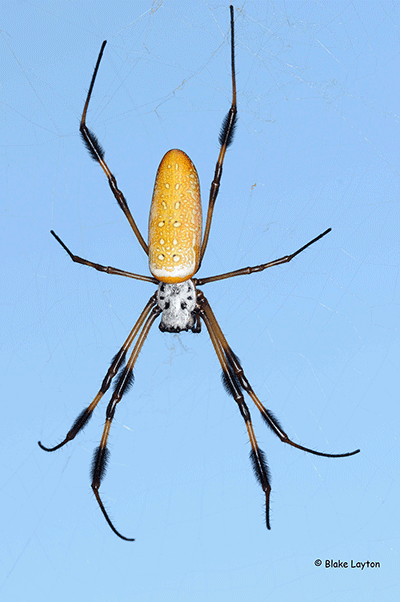Golden Silk Spider, No. 23
 Nephila clavipes
Nephila clavipes
Order: Araneae
Family: Nephilidae
With a hand-sized leg span, these are some of the largest spiders in the state. Golden silk spiders are especially common along the Gulf Coast, where they are often referred to as “banana spiders,” even though this colloquial name is also used for several other spiders. However, their distribution has expanded northward in recent years, and they have become relatively common through much of south Mississippi—south of I-20. The silk really is golden colored when viewed in good light, and it is also quite strong. Though they prefer smaller prey, golden silk spiders catch prey as large as cicadas, and occasionally even vertebrates like lizards and young humming birds in their webs. These spiders overwinter in egg sacs which hatch in the spring. Through spring and early summer, their small webs go mostly unnoticed, but they become much more conspicuous in late summer and fall. Males are much smaller than females, and a single female may have several attending males on her web. These spiders can bite if mishandled, but fortunately, they are not aggressive, and the bite is not seriously venomous, though it can be painful. Black and yellow garden spiders are often mistaken for golden silk spiders, and vice-versa, but these two species can be easily distinguished by the dense bands of black hairs on the legs of golden silk spiders.
Control: Most people don’t want to kill these spiders, but many people are intimidated by their size, and they can be a nuisance when they build webs near entrances or on porches and patios. In such cases spiders can often be relocated by swiping them onto a broom. When necessary, they can be killed by spraying directly with an aerosol wasp and hornet spray, or other properly labeled insecticide.
What is arguably the world’s rarest and most expensive piece of cloth was made from the silk of a closely related spider in Madagascar, Nephila madagascariensis. This 4 foot by 11 foot tapestry was woven from threads made from silk collected from over a million spiders, a process that took four years and more than 80 people to complete. Here’s a link to one of many articles on golden spider silk cloth, http://www.yatzer.com/Golden-Spider-Silk .
Blake Layton, Extension Entomology Specialist, Mississippi State University Extension Service.
The information given here is for educational purposes only. Always read and follow current label directions. Specific commercial products are mentioned as examples only and reference to specific products or trade names is made with the understanding that no discrimination is intended to other products that may also be suitable and appropriately labeled.

